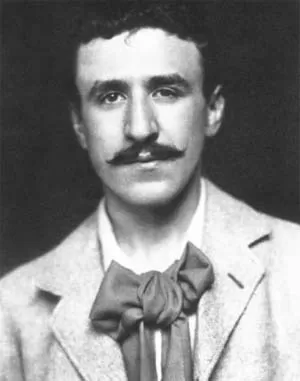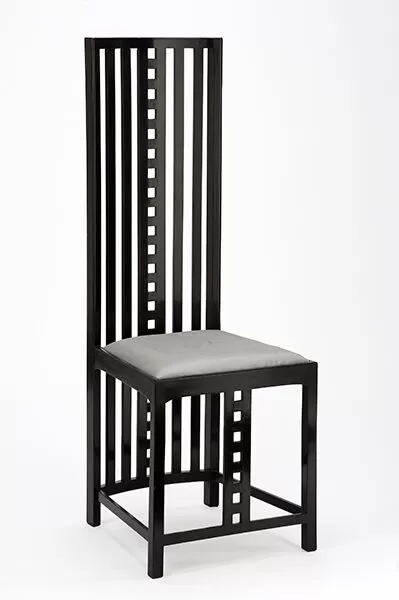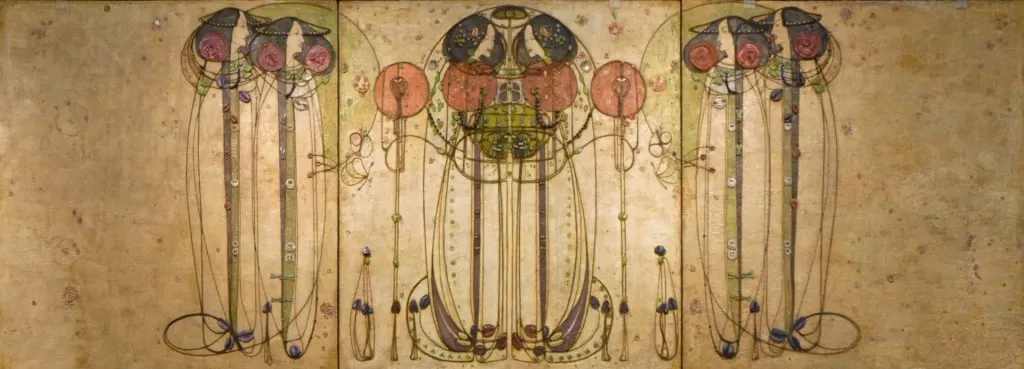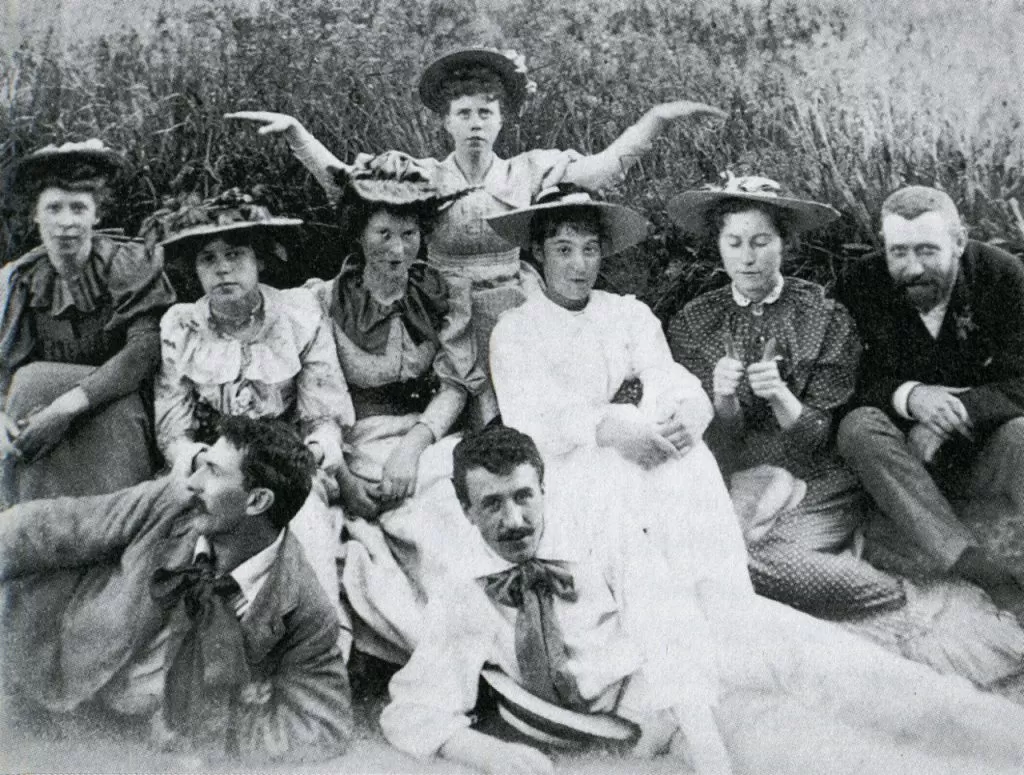The Legacy of the Mackintoshes and the Glasgow Style Lives On in New Exhibit
by Kate Nixon
Fans of Charles Rennie Mackintosh, take note. Designing the New: Charles Rennie Mackintosh and the Glasgow Style, now showing at Baltimore’s Walters Art Museum in its first leg of its American tour, is the first US exhibition in a generation to highlight the architect and designer’s works and explore the wide array of collaborators including artists and craftspeople.
Showing 166 remarkable works of art and design, the exhibition will show many of these works for the first time in North America. The many characteristics of the Glasgow Style, sleek curves mixed with taut lines and stylized natural forms, will be on full display here in this tribute to the unique style that became such a favorite and Mackintosh’s native Glasgow. Revealing Mackintosh’s circle of collaborators, the Glasgow School of Art’s support of women artists during a period of social change, and showing a wide spectrum of iconic works such as posters, high-backed chairs, textile design, watercolor art, metalwork and more, the show provides works from the best of the Glasgow Museum’s civic collections, along with works from The Hunterian, the University of Glasgow, The Glasgow School of Art, and many important works from various collections. In the words of the American Federation of Arts, the exhibition is “the most comprehensive of appraisal of the Glasgow Style ever assembled in the United States.”
Currently, Designing the New: Charles Rennie Mackintosh and the Glasgow Style is showing at the first museum of the exhibits tour, the Walters Art Museum in Baltimore, Maryland. The exhibition also establishes a link between Glasgow and Baltimore as industrial cities that produced rich artistic traditions. Jo Briggs, curator of 18th and 19th century art at Walters Art and curator for the Designing the New: Charles Rennie Mackintosh and the Glasgow Style exhibit recently took some time to answer our questions.
ArtsandCraftsCollector.com: Thanks for taking the time to talk with us. So how was the opening day of the exhibit? Was there a piece that got a bigger reaction than the others?
Jo Briggs: 50 participants actually came through the first day of the tours, so it’s going really well. We’re very design-oriented. We have a big audience for Asian art and it’s interesting to see how Japanese artists influence Mackintosh. In terms of the pieces that people enjoy the most, we have a very large panel by Maragaret MacDonald Mackintosh called “The May Queen” 14 feet long and in three sections, it was the panel she made to decorate one of the famous tea rooms that Mackintosh designed. That piece is pretty stunning in the sense that it’s pretty art nouveau design from a distance. When you get up close, you can see the workmanship is very strong and forceful on it, lots of hidden sections to it. The surface is really complicated. It’s hung at eye level so people can really get a good look at it. I think that’s the piece that’s really stopping people in their tracks.

Margaret Macdonald Mackintosh, The May Queen: Panel for the Ladies’ Luncheon Room, Ingram Street Tearooms, Glasgow, 1900. Gesso, hessian, scrim, twine, glass beads, thread, mother-of-pearl, tin leaf. © CSG CIC Glasgow Museums Collection. Courtesy American Federation of Arts.
ACC: Yes, I’m looking at the image right now. So what is it about Mackintosh’s work that makes it relevant to the American eye? Why is Mackintosh still relevant? Do you think it’s his style, his personal story, or both?

Charles Rennie Mackintosh (1868-1928), Scottish architect and designer. Photo credit: James Craig Annan. Courtesy: Wikimedia Commons.
JB: I think the style of his work is still very relevant. The influence is very minimal, but it’s very different from what we think of in Victorian furniture. It looks very current, I think people enjoy that aspect of it. A lot of people have made the connection to Frank Lloyd Wright, that’s a sort of entry point for Americans, maybe something they’re aware of and can build off of that.
ACC: It’s funny. In researching for this, I came across the book for this exhibit on Amazon with the same name and just because I was curious, I ran a small search on Mackintosh on Amazon and came up with this long list of Charles Rennie Mackintosh-themed coloring books, purses, playing cards, shopping bags, throw pillows… a pretty large list. Is it the desire to connect with that style that keeps him relevant?
JB: It’s interesting, I playfully call it “Mock-intosh” — it’s almost like they’ve made it like Monet’s bridge over the water lilies. But I think the really clean design style, there’s a bit of organicism to it. Even when it’s paired down, it speaks to an age when mid-century modern is still popular with customers and in interior design and I think Mackintosh’s work is not too far away from that.
ACC: So Jo, what is your own favorite part of the exhibition?
JB: I really love the chairs that we have in the exhibition, we have a whole collection of them from different moments of his life. We open with one that he’s designed for the Ingram Street Tea Room, there’s one from the Willow Street Tea Room and you see him progressing towards Art Deco throughout those chairs, they’re kind of an interesting case study. I wouldn’t say no to having one in my house, that’s for sure. (laughs) There are six chairs of his, then there’s a section Glasgow school of art which he designed the building for very famously. It looks at everyone who’s in his circle and professionally collaborating with him, there are a couple of chairs in that portion as well. In addition to that, there are cabinets and mirrors and lamps and tables, it’s a pretty good cross section of furniture in the exhibit. It’s always tough to show the extent of his architectural achievements, but we have great video footage that helps give the viewer a sense of place and there are original drawings featured throughout the exhibit. We hope that viewers will walk away with an understanding of the full scope of what he was doing and he was so detail-oriented at every facet of the interior, it’s all so well thought out.

Designed by Charles Rennie Mackintosh and made by Alex Martin, Chair for The Hill House, Helensburgh, Dunbartonshire, 1904–5. Ebonized wood, modern upholstery. © CSG CIC Glasgow Museums Collection. Courtesy: American Federation of Arts
ACC: So the community of collectors here was quite sad to hear of last year’s fire at the Glasgow School of Art, what a heartbreaking loss. Did that have any effect on plans for the exhibit to help remind everyone of Mackintosh’s legacy?
JB: That’s a great question! I’m not sure about the effect of the fire, but I know Mackintosh’s 150th anniversary was behind it. There’s a real sense of pride in Glasgow for Mackintosh and his buildings are very beloved. It sort of reminds me a bit of Baltimore in that there’s a pride in the art and design of this city and there are buildings here in need of preservation and care. It’s interesting how the school of art particularly, I find it difficult to believe that they wouldn’t bring it back because it’s such an icon for the city.
ACC: I’m sure you’ve been asked many questions about Mackintosh, but what’s the most common question you’ve been asked?
JB: The most common question I’ve been asked? The connection to Frank Lloyd Wright. That’s something to look into, that might be the next show we do. What’s coming through there are the common reference points, namely being Japan. The way I think about it is even though it was the 1900s, there were photographs and I think even Architect’s Digest was not founded until the 1900s, so I’m sure people were aware of what was going on. Photographs were pretty easy to come by, I can’t help thinking that there is a connection there, but equally it is amazing how people come up with the same idea in different places.
ACC: So lastly, are there any additional tidbits of the show that you can reveal to our readers?
JB: The real star for me in this whole show is Miss Cranston or Katherine Cranston who was a female entrepreneur who gave Mackintosh so many commissions over the course of his life. She really kind of stood by him and she ran a series of four tea rooms throughout Glasgow that were highly successful. She also commissioned Mackintosh to build her house, House Hill, and she stands out as somebody who is an interesting female figure. I mean there were female artists in the show, she really stood out as a patron. Someone who understood what Mackintosh was trying to achieve, even though he had a reputation for being quite exacting, she was fine with that because she knew she was going to get a product that was going to draw people in and be exactly how she wanted it. She herself was also very fastidious in terms of design and the clothes that her waitresses wore in the tearoom. She was really wanting to create an artwork in the same way that Mackintosh did, so I’ve come to respect miss Cranston. She’s such a force.

The Wassail from the Ladies’ Luncheon Room Ingram Street Tea Rooms, 1900 par Charles Rennie Mackintosh. Photo credit: Jean-Pierre Dalbera. Courtesy: Wikimedia Commons.
ACC: Thank you so much for your time. Anything else you’d like to say to our readers?
JB: It’s a really wonderful exhibit. The nice thing about it is that there’s such a range of material that’s in there from chairs to cabinets to textiles, metalwork, drawings, watercolors – it runs the gamut and it’s a very rich show.
Admission to the exhibit and Walters Art museum is currently free – The Walters Art Museum is location at 600 N. Charles St. north of Baltimore’s Inner Harbor. For museum information, call 410-547-9000 or visit https://thewalters.org

The Immortals of Glasgow Style. Back Row: Frances Macdonald – Middle Row L-R: Margaret Macdonald, Katherine Cameron, Janet Aitken, Agnes Raeburn, Jessie Keppie, John Keppie – Front Row L-R: Herbert McNair, Charles Rennie Mackintosh. Circa 1894. Courtesy: Wikimedia Commons.
Designing the New: Charles Rennie Mackintosh and the Glasgow Style will run through January 5th, 2020 at the Walters Art Museum. The exhibit will head to Frist Art Museum in Nashville, TN starting June 26th through September 27th before it goes to the brand new Museum of the American Arts & Crafts Movement late October of 2020 through January 2021. The exhibit will finally stop at the Richard H. Driehaus Museum in Chicago, IL February 27th and stay through May 23rd, 2021.
For more information, see the Walters Art Museum website or the American Federation of Arts website.
Walters Art Musuem: https://thewalters.org/exhibitions/mackintosh/
AmFedArts: https://www.amfedarts.org/charles-rennie-mackintosh-making-glasgow-style/
